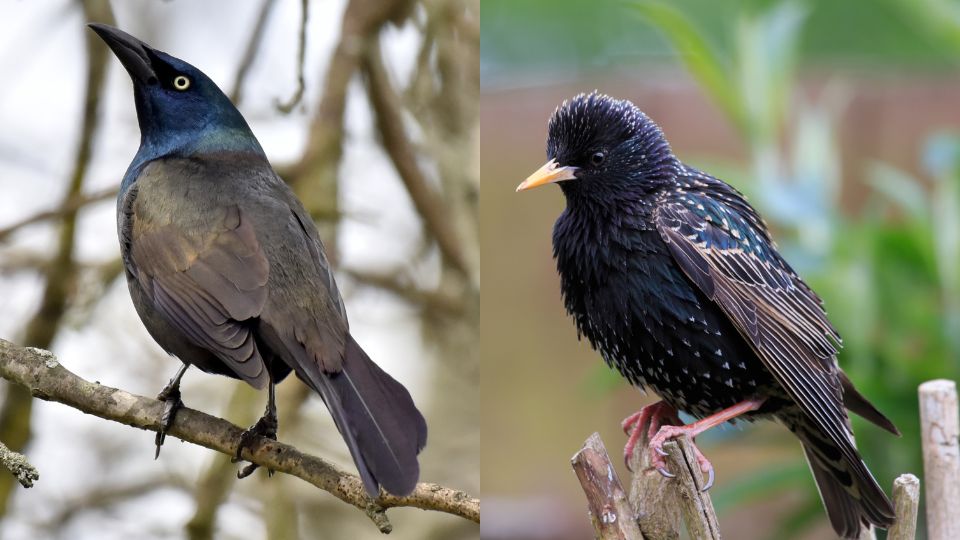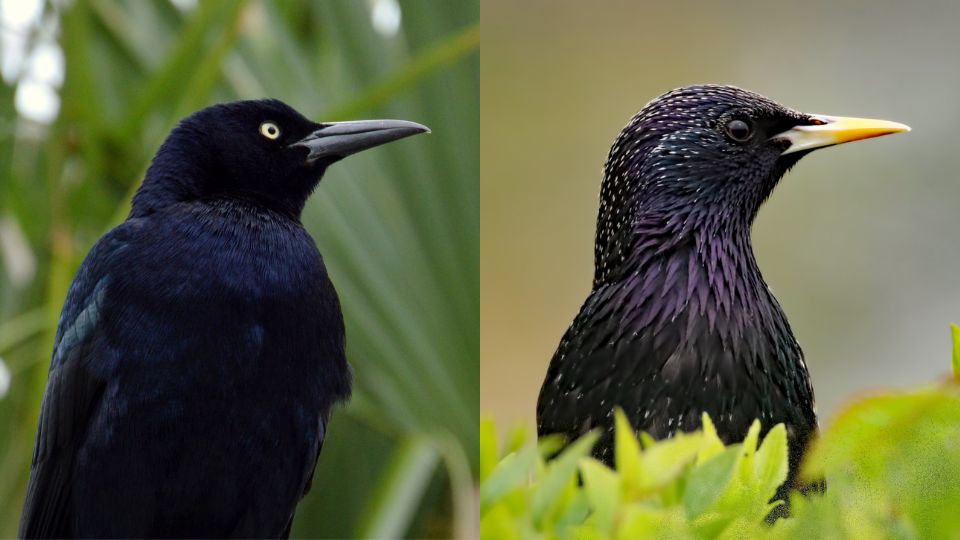To tell the difference between grackles and starlings look at their bills. Starlings have yellowish bills, while grackles have black bills. Grackles are also less aggressive ground-foragers, that dwell in the eastern US. While starlings are seen all over the US eating aggressively at bird-feeders.
Even for experienced bird watchers, it’s hard to spot the difference between grackles and starlings immediately. They are both blackbirds with minor distinguishing features and live in overlapping habitats. With a love of backyard bird-feeders and often traveling in large flocks, there are some simple ways to determine the differences between these two birds. So, let’s dive right in!
Appearance
At a glance, grackles and starlings look very similar. However, small differences in the coloring of their black feathers, size, and small distinguishing features make them stand apart.

Grackles have sheen iridescent black feathers with jet black bill. While they look black at a glance, under different light you will see their coat reflect hues of blue, purple, and green. They have a predominately black head punctuated with yellow eyes, black beaks, and legs. It’s also important to note the common grackles are slightly larger than European starlings.
Starlings have black plumage that boasts speckles of white, brown, or amber – most notably on the underbelly and wings. In contrast to grackles, European starlings have dark black eyes, a short tail, a bright yellow beak, and pinkish legs that make them unique. The starlings have a sharper bill that is ideal for catching insects.
Habitat
Both species of birds live in North America full-time, but that wasn’t always the case. The origins of the European starling hailed from Europe, when this species was set loose in Central Park in the late 1800s. Today, they are one of North America’s widest spread non-native birds.

The common grackle is a permanent resident of the eastern portion of the United States. During the breeding season, they migrate from parts of Canada and lay nests as far down as Florida. Unlike the European starling, grackles are only found in residential areas east of the Rocky Mountains and aren’t seen as far west as California.
The non-native European starling was set loose in Central Park in the late 1800s and have made quite a home for themselves! While some find them to be a bit of a nuisance (they often travel in large and disruptive flocks), starlings are found in every single corner of North America year-round. No matter where you live in North America, odds are starlings are hanging out around your bird-feeders.
Diet
While both starlings and grackles like to munch on similar foods, their eating styles are quite different. Their bills are also shaped differently, which can lend some insight on what types of food they are more inclined to eat.
The common grackle is a gound-feeding bird, which means they forage for food at ground-level. You won’t need to worry about hungry grackles eating all of the seed out of your songbird feeders – they happily munch on loose seed droppings or ground-dwelling insects during the summertime.
The European starlings love birdseed, and large flocks will gobble up an entire feeder in a few hours. For backyard bird enthusiasts, starlings can pose a bit of a problem. Unlike grackles, starlings perch on the side of feeders and drive away friendly sparrows, cardinals, and other seed-feeding smaller birds. Their favorite food is suet, and they will make quick work of suet feeders filled with peanuts or mealworms.
If you want to discourage Starlings from dominating your bird-feeders, opt for safflower seed over cracked corn or sunflower seeds. Opting for plain suet also helps to attract woodpeckers while deterring starlings.
Behavior
While they look similar, the behaviors these two birds display – land on opposite sides of the spectrum. Grackles may look unfriendly, but they actually get along with many other songbirds because of their reclusive nature. Starlings actually appear more easy-going but happen to be strong push-overs when it comes to food sources.

The grackle isn’t a very social bird. During nesting season, it often travels with a small flock and isn’t very aggressive when sharing a backyard tube feeder with other songbirds like sparrows. In the colder months, they travel in slightly larger groups, but their presence isn’t overwhelming to other local birds in the area.

The European starling, on the other hand, is a pest bird. Starlings travel in large groups and are very aggressive when gathered around bird-feeders. When starlings come to the bird feeder party, they often chase off all of the other songbirds. If you see a large group of blackbirds pushing their weight around your backyard bird-feeders, odds are it’s a group of starlings!
Are Grackles and Starlings Pest Birds?
While some birders view grackles and starlings as pest birds, that’s not the case! Sure, they travel in large flocks and often scare away smaller birds, but they also benefit your backyard space.
These birds may seem bossy and in charge, but they are avid bug-killers. Grackles and starlings are known for doing an excellent job of reducing pests in your garden or area. If your garden is out of control, these birds will keep bugs in check. Not to mention the common grackles species is also in decline, with over 58% of its population reduced; bird enthusiasts are recommended to help keep this population supported.
How Can You Discourage Grackles and Starlings from Dominating your Feeders
Backyard bullies get hungry, too! While it may seem frustrating that these backyard birds are scaring off all of the smaller birds, there is a way for everyone to live in harmony. Here are some quick tips to ensure that everyone is fed and happy.
Pick the right kind of bird seed
Grackles and Starlings aren’t too picky, but there are some seeds that they won’t touch. Opt for blends with safflower seeds if you want a feeder dedicated to smaller birds.
Pick the right kind of feeder
Since Starlings are slightly larger than House Sparrows, Bluebirds, and other smaller birds, the right kind of feeder is key. Opt for a tube feeder with a small perch that’s too small for Starlings. Tray feeders are great for Blue Jays, and Starlings will also flock to tray feeders while leaving the food for the smaller birds alone.
Let them be
Sure, it’s frustrating that these birds often scare off other small birds, but they won’t stay for too long. The best course of action is to just let them be. They’ll swoop down in large flocks for a bite to eat and leave to find another food source.

